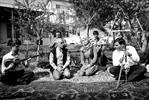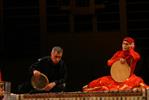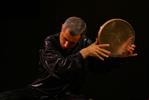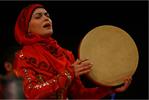The ancient Azerbaijani musical tradition has been kept alive by musicians known as ashugs, who improvise songs while playing a stringed instrument. Another early musical form was the mugam, a composition of alternating vocal and instrumental segments. Among the 90 minutes of world music sent into outer space with the Voyager spacecraft in 1977 are 140 seconds of Azerbaijani mugam.
Folklore songs. The most important genre of musical and poetic creative activity of Azeri people, folklore songs perfectly reflected pure, moral inner world, wishes and expectations of Azeri people.
Folklore songs of Azerbaijan are divided into several genre groups depending on their theme and content, difference in a poetic language and many-coloredness. These groups are labor songs, ceremonial songs, household songs (lyrical songs are also included in this group) and historical songs.
Labor songs are the most ancient of genres of folklore music. The most famous are those devoted to cattle-breeding sayachi songs, while the most popular songs among plant-growers are hovaly labor songs. The most ancient songs are "Choban Avazy", "Tutu nenem", "Saghim mahnisi", "Chichek shumla yeri", etc.
One of the ancient types of Azeri folklore songs are ceremonial songs. Festivities, weddings and funeral processions were accompanied with traditional songs and these songs are popular among people even nowadays. These songs include songs, created in ancient times and performed at various ceremonies and devoted to the Sun, the fire, the rain and other natural forces. Such playful and show ceremonies were accompanied by traditional ceremonial songs. The songs are based on works of bayaty , the widely spread form of folklore literature.
Household songs are divided into nursery songs, humoristic songs and satiric and lyrical songs, according to their content, form and feelings expressed. Nursery songs, especially those sang by mothers to their children - lullaby songs are the most ancient ones among all other household songs. Lullaby songs comprise ninnies, layla and okhshama.
Genre of lyrical songs is the most rich and wonderful genre of music. Lyrical songs at the same time, account for the most part of this music. Lyrical songs mainly cover the theme of pure love, beauty of love, separation, expectation, grief, sorrow, etc
Lyrical songs became the most important means of people's self-expression. Some of these songs are optimistic, while others are sad, and full of sorrow. The specific feature of the first group of lyrical songs is a lively rhythm, segah style, while the second group is characterized by such exclamations as "Ah", "Vay", the style of "Bayaty Shiraz" and alternation of 6/8 and 1/2 times, etc. The first group includes such songs as "Gul oghlan", "Yaz bize gonag geledjek", "Qoy gulum gelsin", etc; the second group comprises "Senden mene yar olmaz", "Onu deme zalym yar", etc. Lyrical songs are of more complex form. They are characterized by a couplet form, form, analogous to rondo form and complex two part form, repetition of verses, sequentism , etc.
Epic-historical and heroic songs also occupy an important place among the folklore songs of Azerbaijan. These songs, that have been created since ancient times are devoted to historical events, taking place in Azeri people's life or people's heroes, which played a great role in the life of people.
Songs about Koroghlu, his love Nigar, devoted friends delis and devoted horse Qirat serves an example to that.
Eposes and songs about Qachaq Nebi, Qachaq Kerem, Deli Aly and other characters were also composed. These include such songs as "Geden gelmedi", "Piyada Koroghlu", "Gachag Nebi", etc.
Dances. Dance music, along with favorite genre of music, is one of the widely spread and important components of national folklore music. Folklore dances are basis of the Azeri national instrumental music. The dances are created by the people and passes through generations. Instrumental folklore dance music of Azerbaijan is characterized by richness of music, symmetric structure, diversity of diapason, gradual intensification, repetition, variation and method of sequence. Dances are distinguished by specific tune, metro-rhythmic properties and colorful forms. Like folklore songs, dances also reflect people's feelings, emotions, character and temperament.
Dances of women are specific for their lyricism, tenderness and grace, for example "Vaghzaly", "Uzundere". A number of dances can be performed only by women, "Nelbeki", "Djeyrany". Male dances are characterized by stormy emotions, energetic rhythm, power and temperament. These are "Qaytaghy", "Djengy", "Qazaghy", "Khanchobany", etc.
Collective dances are also popular among the population. Most of them accompany working process and household ceremonies. The dance "Halay" is one of these dances. Vaghzaly usually accompanies weddings. The dance "Yordu-yordu" can be performed by both men and women. The most ancient collective dance is a widely spread "Yally", which dates back to ancient times.
Mugam. Traditional professional genres also developed along with genre of music and dances of the Azerbaijan musical folklore. Mugams were the most important of them. Mugams are the greatest pattern of folklore vocal instrumental compositions of deep and rich, complex, emotional meaning, the peak of national classic music of Azerbaijan and peoples of Near and Middle East. Since ancient times, the stable development of mugam helped its formation and enrichment. Mugamat , mugam (i.e. complex of literal senses) consists of 12 mugams, Ushshaq, Neva, Abuselik, Rast, Iraq, (Eraq), Isfahan, Zirefkend, Buzruk, (Bosorg), Zengula, Reavi, Huseyni, Hidjas, 24 parts, 48 nooks, 6 avazs, colors and tensifs. The term muhgam is used in two meanings. The first is the equality of tunes. At present there are seven tunes in Azeri folklore music and a number of mugams: Chahargah, Shushtar, Bayaty-Shiraz, Humayun, etc. The second part means musical composition of a specific form, interesting and complex, consisting of several parts. Mugam is compared with suite-rhapsody and symphony due to its form. This composition bases on a specific tunes, on mugam and develops in frames of laws, established in mugam. Performers of mugam, a singer and accompanying troupes (trio-tar, kamancha, def) or solo instrumentalists contributed various alterations, new shades, points, trills, etc depending to their creative fantasy, skill, talent. Singers perform mugams on lyrical-philosophical gazelles of well-known poets _Khagani, Nizami, Nasimi, Fizuli, etc.
In mugams the improvised parts of mugam alternate with exact metrorhythmic parts of mugam that are vocal tesnifs and instrumental rhythmical
The improvisation of Azeri mugams is more frequent and brighter compared with mugams of other people. Therefore, professional performers of mugam are also the authors of this type of mugam. Zerbi-mugam is another type of instrumental vocal mugams of Azeri people. This includes "Heyraty", "Arazbary", "Ovshar", "Mansuriyya", "Shimai-shems", "Keremi", "Kesme-Shikeste", "Garabag-shikestesi". The peculiarity of these mugams is that the improvised part of a vocal mugam of a singer is performed on the exact metrorythmic accompaniment.At the same time a def or a def and a drum occupy an important place in the accompaniement by a saz trio. The saying mugams of vocal parts are characterized with a melody of a rich a rich ornament starting from the highest diapason.
Creative activity of Ashugs. Beside mugams, professional oral traditions of the music of Azerbaijan include the musical and poetical creative activity of ashugs. The wotd "ashu" is derived from the word "eshg" ("love") and means the devotedness to one's profession. As a term it developed in the 14th century. The art of ashugs, which emerged in ancient times was popular among the people as it praised the wishes and expectations of people.
The art of ahugs, being democratic in its expression, bears a wide contes and is diverse and colorful. It includes songs, praising love, friendship, satiric and lyrical songs, as well as songs, praising heroism of people, their freedom and historical eposes. The art of ashig is a synthetic one as a poet creates poems, composes music, and performs these songs playing on tar and dances. Ashug is frequently accompanied by balaban and wind bands. However, the saz is the principal instrument of the ashug. Saz is an ancient string musical instrument of Azerbaijan. Due to its wonderful timbre, it was also glorified by poets. The most widely-spread genre of the art of ashugs are eposes, especially heroic-historical eposes. Vocal-instrumental parts are replaced by poetic words in eposes.
The epos, devoted to the national hero of 16th century, fighter against feudal and foreign occupants, a man of courage Koroghlu, is famous worldwide. The heroism of Koroghlu was glorified in "Koroghlu djengisi", "Atly Koroghlu", "Piyada Koroghlu", "Koroghlu", and other ashug songs of the epos. The heroic song "Misri"glorified the period of the most intensive competition between ashugs. Two, three even four ashug may take part in the competition and improvise on a definite topic.
Praises and gozellemes are the most famous components of the lyrical genre of the art of ashugs. These gozellemes may be dedicated to either a beautiful women or to the man of counrage Koroghlu or his legendary horse Girat. The most wonderful patterns of the ashug lyricism are lively songs as "Afshary", "Sherili" and others that are usually full of sorrow such as "Yanyg Keremi" and "Dilgemi".
The genre comprising moral songs is also interesting one in the art of ashugs.
Such poetic forms of the national poetry as gerayly, divani, qoshma, tedjnis are the most preferred by ahugs along with the genreas of poetry (qoshma, mukhammas, ustadname, gefilbend)
The most widely spread poetic meter of the ashug creativity is one based on the number of syllables. The majority of ahug songs are written in forms of couplets. Each couplet is preceded by preface and couplets are separated with an instrumental solo.
Azeri ahugs are distributed among definite zones and differ due to the local characteristics of ashug's art. For example, ashugs of Goyche, Ganja, Kelbedjar, Gazakh, Tovuz, Borchaly, Shirvan, Salyan differe in their creations and purposefully preserve and secure traditions of their personal creative activity.
In ancient times and in Middle Ages Agugs were called "ozan", "Varsag", "dede".
The most ancient, written source Kitabi Dede Korkut of the seventh century is devoted to heroism, patriotism, love and life of ozans, the ancestors of contemporary ashugs of Azerbaijan.
Over that 1300 years ago Ded Korkut wished that the stability and piece would not leave our lands and houses and ozans would create and sing. Therefore, ozan is a wise old man, who knows everything, the honesty of people and their meanness. Dede Korkud was one of those men. The major instrument of Oghuz ozans was qopuz and by some legends, this instrument was created by Dede Korkut, who played on it with a great skill.
Through centuries the ozan-ashug creations of Azerbaijan influenced on other fields, kinds of musical genre and later on the creative activity of modern composers. U.Hadjibeyov was the first to use the unrivaled properties of Ashug music with great professionalism and skill (opera "Koroghlu" the masterpiece, composed by U.Hadjibeyov). Another composer Gara Garayev created the synthesis of technical means of modern music and ashug music also with a great skill in the second part of the third symphony.








